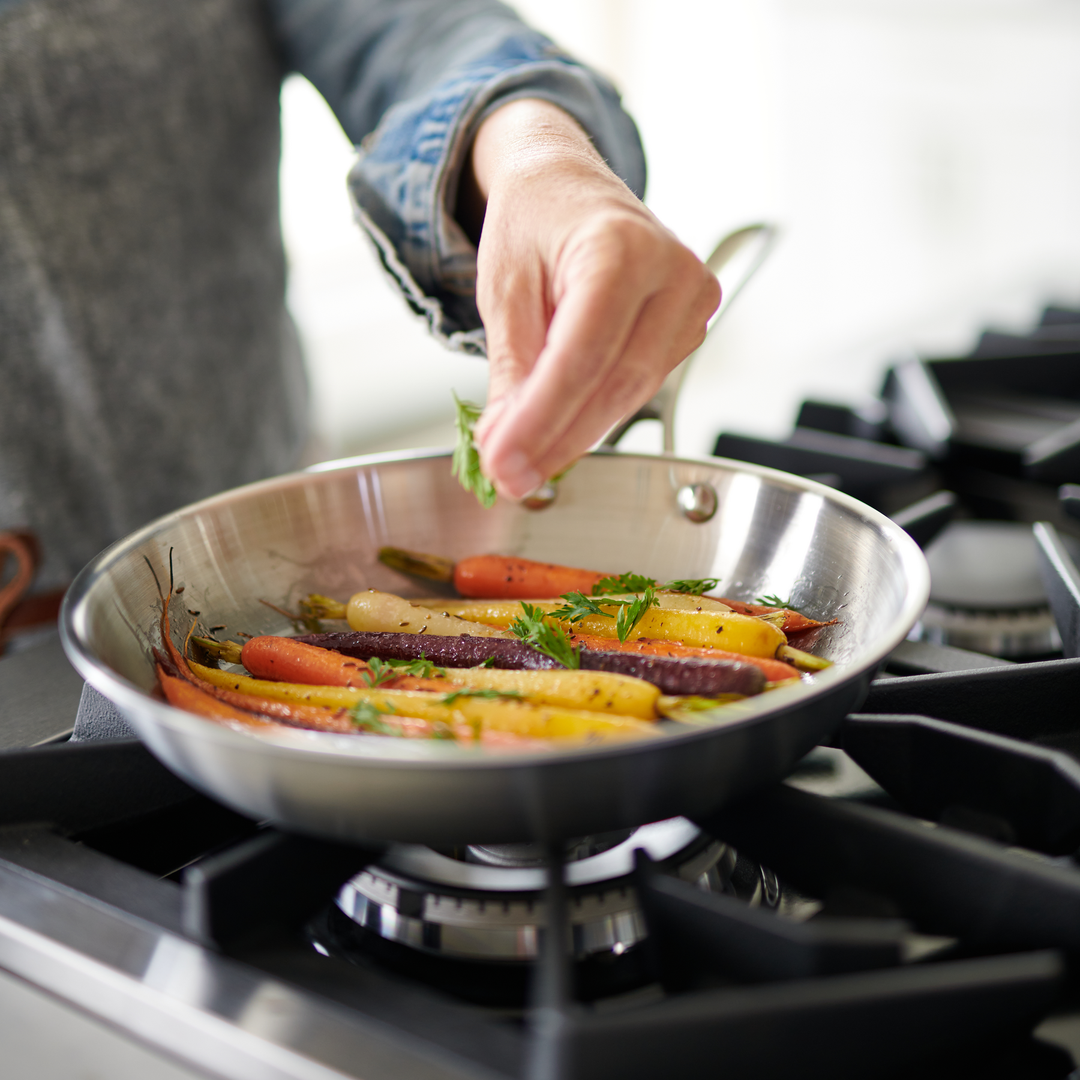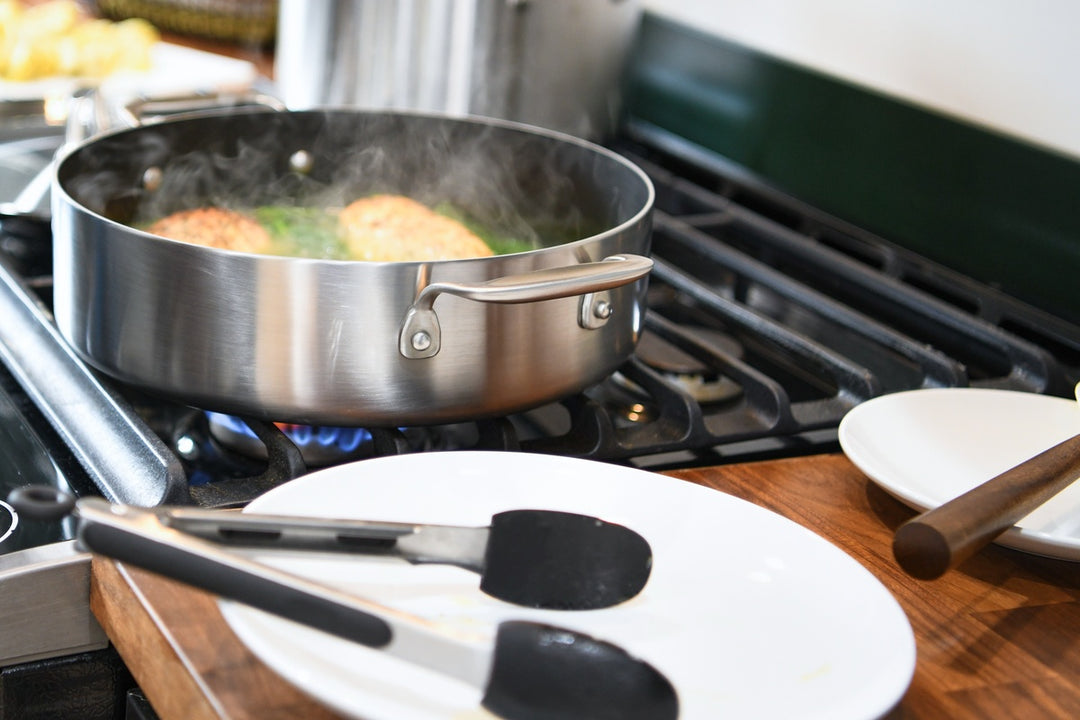How to Clean Stainless Steel Cookware

There’s nothing quite like the classic style and superior performance of stainless steel cookware. And when you get a piece (or two…or three…) from American Kitchen, you know you have quality that’ll last generations.
Blame stainless steel’s rising popularity on the construction (it’s made of two layers of pro-grade stainless steel wrapped around a layer of super durable aluminum), consistent heat conductivity, or workhorse durability. Or the fact that American Kitchen’s stainless steel cookware is oven safe up to 500 degrees and compatible with all cooktop surfaces—electric, gas, induction, ceramic glass, you name it.
If you want your stainless steel cookware to look as great years from now as the day you bought it, listen up. Here’s a few tips to keep your cookware clean and performing for years to come:
How to Clean Everyday Messes
While your pan is still warm, take a paper towel and wipe away as much grease and bits of food as you can. Although it’s tempting to throw your stainless steel pans in the dishwasher with the rest of your dishes, it’s best to hand-wash your cookware (humidity plus overly strong detergents can corrode the metal).
After your pan has completely cooled down, use hot, soapy water and a soft sponge to clean your cookware. Stay away from scouring pads, steel wool, or anything too abrasive as these can scratch the surface. Next, use Bar Keepers Friend to give it that brand-new-cookware gleam.
How to Clean Stuck-on and Burnt Messes
Maybe you decided to tackle your Friday night dinner dishes on Saturday morning or got distracted by a phone call and your meal got a little burnt. Whatever the reason, staring down a pan with gooey or burnt food stuck it can seem daunting. The good news is that getting your cookware looking new again is nothing some steam and soapy water can’t fix.
First, it’s important to always allow your cookware to completely cool to avoid thermal shock and warping. Next, wipe away any loose particles with a paper towel. Then, place the pan on the burner and fill it with warm water so that the entire bottom surface is covered. Set the burner to medium/low and heat for a minute or two. If the burnt or sticky food has run up the side of the pan, feel free to place a cover on and let the steam work its magic. Use a wooden utensil to gently scrape food from the pan. Lastly, turn off the heat, empty your pan, and wash with soap and water.
Pro tip: for extra stubborn, burnt-on foods you can soak your pan in hot soapy water and then gently rub a paste of water and a non-abrasive, non-chlorine stainless steel cleanser such as Bar Keeper’s Friend. Rinse, then finish off the job by washing in warm, soapy water and towel drying your pan.
How to Clean Residue
After your pan is nice and clean, you may notice some rainbow-looking discoloration. No, you’re not seeing a mirage, but rather the signs of heat tint. Heat tint is most likely from your pan getting overheated or letting acidic foods sit for too long. While these discolorations don’t affect the performance of your pan, they can be annoying to look at.
After washing your pan with soap and water and towel drying, fill it with 1” of distilled white vinegar to cover the stains. Do not use any other type of vinegar as the included additives may harm the pan. Use a soft sponge to gently rub away the stain. Rinse pan and towel dry and voila! Good as new.
How to Clean White Spots
Most people are surprised to learn that white spots or a chalky white finish on your pan is actually the result of using tap water on your pan. Tap water’s natural calcium, lime, and other mineral levels can react with heat and form calcium deposits that may eventually lead to more buildup. Before you panic, try these tricks to get your pan looking like new.
After allowing your pan to completely cool, fill it with warm tap water, leaving at least 1” from the top. Add 3 to 4 tablespoons of distilled white vinegar. Do not use any other type of vinegar as the included additives may harm the pan. Heat pan and vinegar solution on the stove on medium/low heat while using a wooden utensil to gently scrub the pan’s surface. When the solution comes to a boil, turn off the heat and occasionally stir the solution until the pan cools. Empty pan and wash it in warm, soapy water and towel dry.
Pro tip: for stubborn calcium stains, soak your pan in a water and distilled white vinegar solution. When the stains have disappeared, wash in warm, soapy water and towel dry.
What to Do About Pitting:
If you’re seeing a series of dull dots on the surface of your pan, you’ve most likely got some pitting. While pitting doesn’t affect the performance of your pan, it certainly doesn’t contribute to its beauty. Pitting occurs when the layer of chromium oxide on a stainless steel pan that’s used to prevent rust comes into contact with chlorine or cooking salt and begins to break down.
The good news is that pitting can be prevented with some simple steps. For example, when adding salt to water, make sure that the water is already boiling. Since salt dissolves in boiling water, it won’t sink to the bottom and affect the pot or pan’s surface. Similarly, when salting other foods, make sure that they’re hot already so that the salt melts immediately upon contact.
We recommend never salting foods in cold cookware, or even putting the finishing dash on at the dinner table or in the serving dish rather than in the pan. Lastly, never use bleach or abrasive cleaners that contain bleach on your stainless steel cookware.




